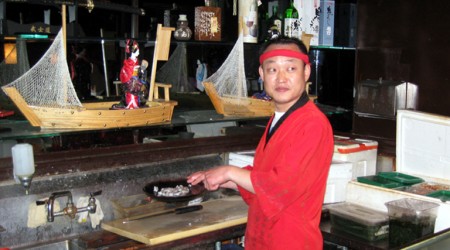Live octopus
Korea
Octopus Paul has been eerily accurate in predicting the World Cup winners; his cousins in fish tanks throughout Korea would do well to develop enhanced psychic abilities or they could end up segmented and writhing on a plate. Fortunately for Paul, he is too large to end up as sannakji hoe (a Korean dish involving the quick dismemberment of a small octopus with the severed tentacles delivered in a squirming mass to your table). Opponents of this type of cuisine argue that it is cruel to eat a live animal, but rest assured that Otto is very dead while his limbs are playing angry cobra on the plate. The octopus’ nervous system functions differently than in higher life forms – it is the same kind of reaction as an insect’s lost leg continuing to dance or that frog drowned in formaldehyde in biology class that starts kicking when he’s dissected. The hope is that the chef is talented and lighting fast at dispatching the octopus, but if you decide to try this unusual cuisine, you’re better off not knowing.
Friend Rex Kim had told me about a place in Los Angeles’ Koreatown that serves the dish; the restaurant goes by the odd name of the Beverly Living Fish Center (which makes it sound like a place where the wealthy go to stock their koi ponds). Beverly Living Fish Center (we’ll call them BLFC to conserve bandwidth) is in an industrial-looking building, but you know you’re in the right place when you are ushered past the tanks full of the eight-armed mollusks. Once inside the dining area, the decor improves drastically. Joined by Rex and friends Joshua Joseph (Trippy Food’s webmaster) and Hui Wang, we ordered a platter of the sannakji hoe, while I supplemented the dish with a dosirak lunch, the Korean equivalent of the bento box. Hui ordered the eel, and I was intrigued to see how that was going to be presented. Since we were all going to partake of the octopus, we had them bring that out first. It was obvious as to how soon we’d see it at the table since we could hear the familiar repeated whack of the cleaver from the nearby preparation area. When the plate arrived there was a moment of silence, not in memory of the fallen mollusk, but in amazement at what we were seeing. Sitting on the plate was something that can only be described as looking like Medusa’s head. A myriad of free-roaming appendages were scrambling about the plate, apparently trying to figure out why they were no longer a part of the collective. We dug in with our chopsticks, but getting just one of the tentacle segments to our mouths was work, as they did not want to go. The pieces had to be literally pried off the plate, as their very efficient suction cups were working overtime on the graveyard shift.
The taste was more of a disappointment than the texture and experience – uncooked, there was an ever-so-slight oceanic taste to them, but otherwise quite bland. A dip into the soy sauce gave it a little flavor, but also added some fight to it. Not being connected to a brain, the limbs are apparently unaware that they are dead. This means that if your are successful in wresting them from the plate, introducing them to your gaping maw does nothing to reduce their survival instinct – be aware that they WILL try to attach themselves to any semi-solid object in your mouth they can find. Since semi-solid objects include your throat, it is imperative that you chew the hell out of them before swallowing (the old “shoot and swallow the oyster whole to get it down” trick doesn’t bode well here). This is probably the part that most people don’t like, since even cooked octopus has a chewy reputation. I would describe the experience as eating live rubber bands. The floorshow was not limited to the octopus, as Hui’s eel selection came to the table on a hot plate with what looked like tiny dancing maggots strewn across the top. The moving part defied explanation – closer inspection showed them to have no real structure (although we couldn’t rule out flatworms) – they literally looked like tiny moving pencil shavings. We later discovered these to be bonito flakes, finely shaved and dried skipjack tuna. The dried flakes react with the steam, causing them to absorb moisture and expand. Besides the entertainment value, the bonito adds flavor since it is generally fermented and smoked during the drying process. As for the eel, the preparation was traditional (with brown eel sauce topping) – since Hui is the sharing sort, we all had a bite, and I can tell you that it was delicious.
Live octopus can fall outside most people’s comfort zone, but what little taste is present is inoffensive, and if you chew it, there is little or no risk to your health. It’s worth a try for the entertainment value if nothing else, and you can sleep soundly knowing that the little bugger was in octo-heaven while you were chomping down on his squirming limbs. One thing is for certain – it will be an experience that really grabs you.
Beverly Living Fish Center
4356 Beverly Boulevard
Los Angeles, CA 90004
GPS coordinates: 34°4’33.93″N 118°18’13.68″W
See images of Val and friends eating octopus and other unusual aquatic goodies
Watch video of Val and friends eating live octopus and eel with bonito flakes





I dig the 70s intro on our video. 😉
If only we had some “Starsky and Hutch” music…